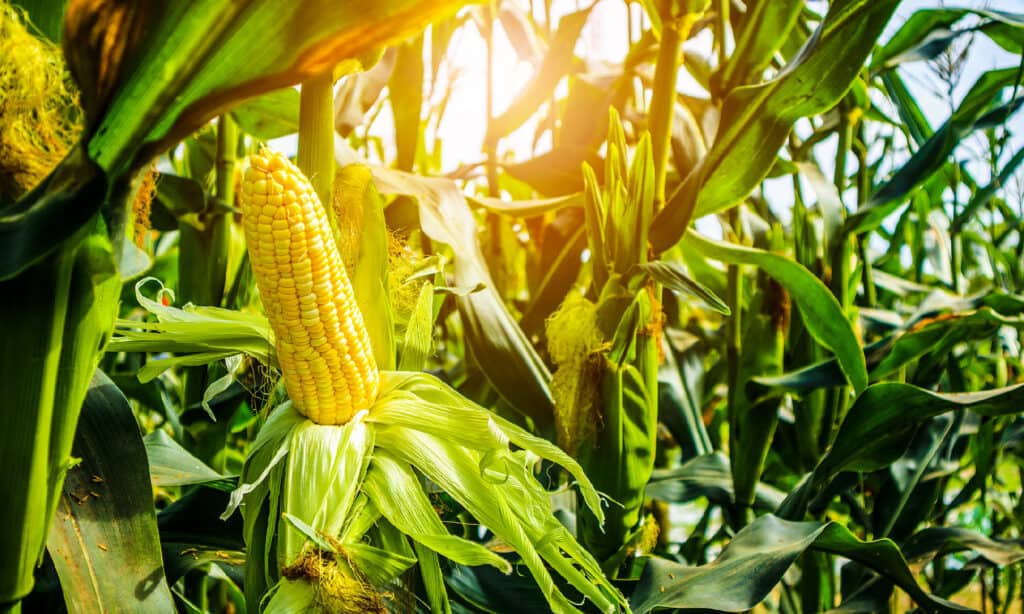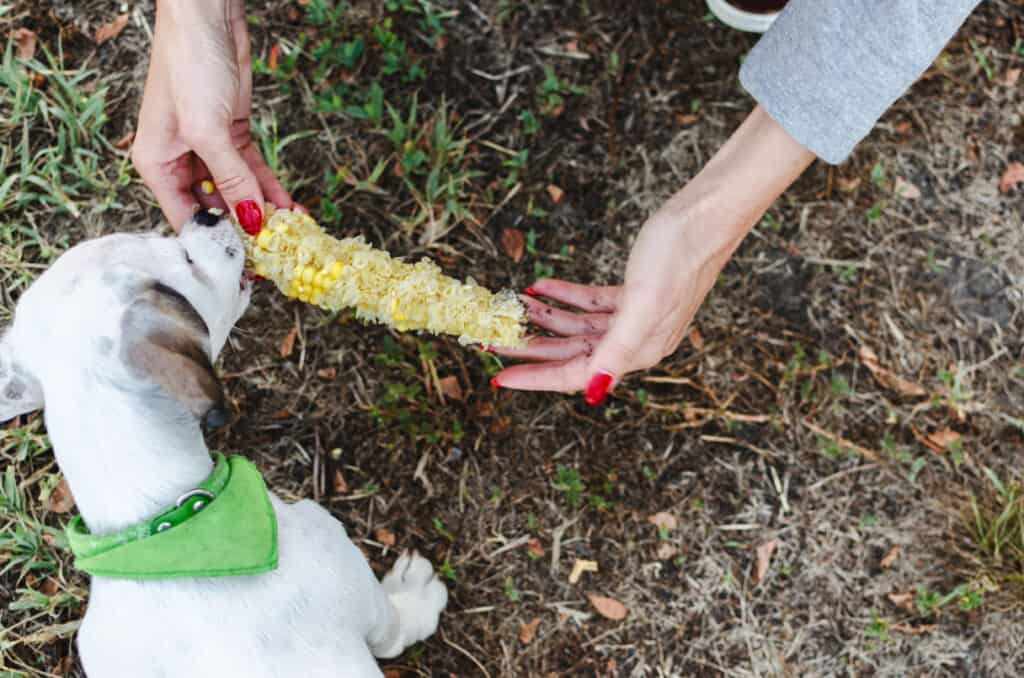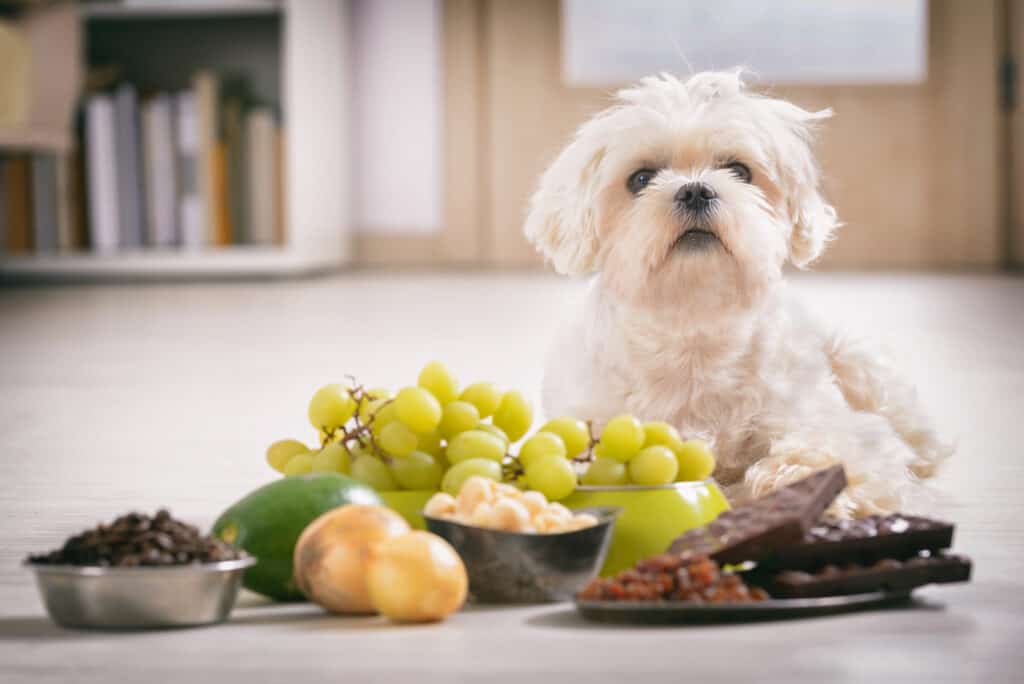The image of hot, buttery corn-on-the-cob conjures up images of lazy day barbecues and good times. It’s a delicious treat for sure, but happens to those waste corn cobs? It’s best to be extra careful, because they are a real danger to our dogs. Let’s discover whether dogs can eat corn cobs or not.

It’s best to be extra careful, because they are a real danger to our dogs. Let’s discover whether dogs can eat corn cobs or not.
©iStock.com/Kwangmoozaa
Are Corn Cobs Safe For My Dogs To Eat
No, corn cobs are not safe for dogs. Even though corn isn’t toxic, the hard central cob is indigestible, sharp, and poses a big choking or intestinal blockage hazard. Never give your dog corn cobs. Even chopped-up corn cobs are dangerous.
What Are Corn Cobs?
Corn cobs are the woody central section inside a sweetcorn ear that the yellow kernels grow on. They eventually fall off if they’re not harvested, or more likely we eat them and leave the cob for trash.
Most people have seen a corn cob if they’ve eaten corn-on-the-cob. Once the sweet yellow corn is gone you’re left with the grey inner stalk and that’s the “cob”.
Waste corn cobs are used in the biofuel industry, as cattle fodder, cat litter, animal bedding, soil conditioner, and environmentally friendly rodenticides, so they aren’t a waste product without use. In fact, years ago corn cobs were turned into tobacco pipes.
Corn cobs are sometimes called a corn pole and in Britain, a corn cob may refer to a round loaf of bread called a “cob”.
Cobs are much like foam plastic when the corn is fully grown, but baby corn is thin and juicy. Dogs can eat baby corn if they’re cooked until soft.
What Are The Risks of Corn Cobs?

When feeding your dog corn, be careful not to let them eat the cob itself, which can cause choking and intestinal, blockage.
©iStock.com/RobertoDavid
Corncobs are a natural product and it may not seem like a risk if your dog is happily chewing one to pieces, but there are some potential risks with a high price to pay.
Choking
A corn cob with or without corn kernels is a dangerous object for a dog. They’re large enough to cause choking in the biggest breeds. The cob itself is enough of a hazard, but the risk increases because we tend to eat corn-on-the-cob with metal implements. Skewers and kebab sticks in the cob creates a secondary choking hazard.
Wounds
Corn cob is sharp enough to scratch a dog’s mouth, gums, and cause throat or intestinal injuries as it makes its way down to the stomach.
Mouth and internal wounds can get infected. Not only is this painful and distressing it’s extremely expensive.
Internal blockages
Ruminant grazing animals like cows and deer can eat corn cobs because they have a different digestive system from dogs and humans. They are easily able to digest woody corn cobs, in fact, corn cobs are often used as fodder.
In contrast, canines cannot digest fibrous corn cobs and this makes them a huge blockage hazard. Unless the dog can pass the cob in its stool, it will sit in the intestines or stomach presenting a bowel obstruction.
Dogs are capable of chewing up a corn cob and they will enjoy getting stuck in, but they can’t digest the pieces they swallow.
Burns
Many of us know corn-on-the-cob retains ferocious heat, especially if it’s straight off the barbecue. Dogs can receive burns from corn-on-the-cob that damages their mouths and leads to infections.
Butter and Flavorings
Corn-on-the-cob is delicious when it’s smothered in hot butter and salt, but these are unhealthy for dogs. Butter, or other oils, are fatty and lead to obesity if they’re regularly eaten. Fatty foods can also cause painful diseases like pancreatitis. Pancreatitis is when the pancreas digests itself. It’s very painful for humans and dogs alike.
There are also flavorings like garlic butter or fried onions associated with corn-on-the-cob. These are a problem to because alliums are toxic to dogs – more on that later.
What Are the Health Benefits of Corn Cobs?
It’s too risky to give dogs corn cobs, so there are no health benefits, but corn without a cob is good for dogs and provides several nutrients.
- Protein – builds healthy muscles, skin, and coat. It also mends damaged muscles
- Carbohydrates – corn provides a low-fat energy source that keeps dogs full of life
- Linoleic acid – an omega fatty acid that boosts the immune system and maintains a glossy coat and healthy skin
- Antioxidants – key antioxidants protect the body from cell damage
- Beta carotene – is essential for good vision and a powerful immune system
- Fiber – fiber contributes to healthy bowels and regular stools.
Can Dogs Eat Corn?

It’s too risky to give dogs corn cobs, so there are no health benefits, but corn without a cob is good for dogs and provides several nutrients.
©iStock.com/Firn
Yes, dogs can eat loose corn. Corn is a healthy ingredient in a dog’s diet, they are omnivores after all so healthy non-toxic fruit and vegetables are excellent food for our canine companions. If your dog is eating a comprehensive good quality commercial dog food he won’t need extra corn, but sometimes it’s nice to give them a little treat. The ASPCA recommend treat make up no more than 10% of a dog’s daily diet, so don’t go overboard!
What About Tinned Sweetcorn?
Tinned sweetcorn is fine for dogs, but it should be drained and rinsed first. That’s because tinned sweetcorn is preserved in various liquids such as salty brine. Salt intake can lead to hypertension and dehydration in dogs.
Tinned corn should be plain, any extras like garlic, sugar or spices aren’t suitable.
My Dog Ate A Corn Cob What Do I Do?
If your dog is choking on a corn cob immediate first aid can save their life. Here’s how to remove it:
Restrain your dog, open his mouth and do a finger sweep to remove any obstruction. If you can’t reach it, use tongs or even pliers to grab hold, but don’t push it further down.
If you can’t reach the corn cob, you’ll have to perform the Heimlich maneuver. It’s the same one you’d use on a choking human.
- Small dogs can be picked up and placed against your legs, head down, stomach up. Push sharply towards their head in the soft hollow beneath the rib cage with your fist.
- Large dogs can be led down on their side. Position yourself behind their back and push your fist sharply into the hollow beneath their ribs in an upwards motion towards their head.
Use quick fast motions because this will push air from their lungs and hopefully eject the corn cob. Always have a vet check-up after a choking incident.
If your dog hasn’t choked, he’s not out of the woods yet. It’s important to monitor your dog closely. Some are able to pass corn cobs in their stools, but because they’re indigestible they may get stuck and cause a life-threatening obstruction.
Check your dog’s poo for corn cob remains (they can take up to 72 hours to pass through) but if they show the following signs of blockage it’s important to see a vet.
- Sickness
- Diarrhea
- Lethargy
- Straining at stool
- Reduced appetite
- Sore stomach or abdomen
What Foods Are Dog Toxic?

There are several types of food which can poison a dog.
©iStock.com/humonia
Corn isn’t toxic, but there are several types of food that can poison dogs. They include:
Artificial sweetener xylitol
This common addition to Jell-O, cakes, biscuits, Haribo and sweet treats causes a large blood sugar drop in dogs and potential hypoglycemia.
Grapes and raisins
This fruit can cause kidney failure though experts aren’t sure what exactly causes it. All color grapes, raisins, juice and wine are toxic.
Chocolate
They may like the sweet taste, but dark, milk, and white to a lesser extent, all contain theobromine and caffeine which are stimulants that can cause organ failure. Chocs may contain xylitol too.
Macadamia nuts
These nuts are often baked into cakes and biscuits which are prime snaffle targets from the kitchen counter. Macadamia nut compounds are indigestible and also capable of causing organ failure.
Black walnuts
Black walnuts contain indigestible compounds and frequently grow a type of mould that’s toxic to dogs.
Garlic, onions, leeks, shallots
Alliums are dog-toxic. They contain compounds that bind to red blood cells and cause anemia.
Corn Cobs are Dangerous to Dogs
So, we’ve learned that corn is not toxic to dogs, in fact, loose corn has health benefits, but corn cobs are dangerous.
They pose a serious choking hazard and because they’re indigestible can cause intestinal blockages. It’s not worth the risk, no matter how much your dog enjoys chewing cobs.
Barbecues are prime times for dogs to get caught out with a corn cob and need the kind of bank-breaking surgery we’d all like to avoid, or worse, death via choking.
Dogs and corn cobs do not mix! If you want your dog to eat sweetcorn, make it the loose kind and keep corn cobs under wraps, sealed in a dog-proof trashcan, or high up out of reach.
Up Next
The photo featured at the top of this post is © iStock.com/prayong kotjuk
Ready to discover the top 10 cutest dog breeds in the entire world?
How about the fastest dogs, the largest dogs and those that are -- quite frankly -- just the kindest dogs on the planet? Each day, AZ Animals sends out lists just like this to our thousands of email subscribers. And the best part? It's FREE. Join today by entering your email below.
Sources
- British Veterinarian Association, Available here: https://www.bva.co.uk/news-and-blog/news-article/keep-corn-on-the-cob-away-from-your-dog-urge-vets
- SmokeKing, Available here: https://www.smoke-king.co.uk/pipes/missouri-meerschaum-corn-cob-smoking-pipes
- RSPCA, Available here: https://www.rspca.org.uk/adviceandwelfare/pets/dogs/health/firstaid
FAQs (Frequently Asked Questions)
Is it ok to feed your dog corn on the cob?
It’s too risky to give dogs corn cobs, so there are no health benefits, but corn without a cob is good for dogs and provides several nutrients.
Can a dog have canned corn?
Tinned sweetcorn is fine for dogs, but it should be drained and rinsed first. That’s because tinned sweetcorn is preserved in various liquids such as salty brine. Salt intake can lead to hypertension and dehydration in dogs.
Thank you for reading! Have some feedback for us? Contact the AZ Animals editorial team.






